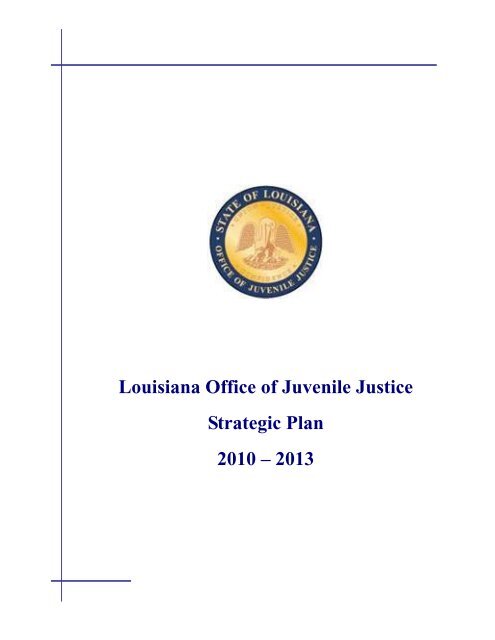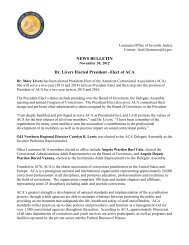Jan 1 Strategic Plan - Office of Juvenile Justice - Louisiana
Jan 1 Strategic Plan - Office of Juvenile Justice - Louisiana
Jan 1 Strategic Plan - Office of Juvenile Justice - Louisiana
You also want an ePaper? Increase the reach of your titles
YUMPU automatically turns print PDFs into web optimized ePapers that Google loves.
<strong>Louisiana</strong> <strong>Office</strong> <strong>of</strong> <strong>Juvenile</strong> <strong>Justice</strong><strong>Strategic</strong> <strong>Plan</strong>2010 – 2013
<strong>Office</strong> <strong>of</strong> <strong>Juvenile</strong> <strong>Justice</strong>MissionThe <strong>Office</strong> <strong>of</strong> <strong>Juvenile</strong> <strong>Justice</strong> protects the public by providing safe and effectiveindividualized services to youth, who will become productive, law-abiding citizens.VisionOJJ is a quality system <strong>of</strong> care which embraces partnerships with families,communities and stakeholders to assist youth in redirecting their lives towardresponsible citizenship.Guiding Principles:HonestyTo be honest; do everything with integrity.Achievement To be outcome-oriented in achieving results consistent with our mission.VersatilityEthicalFocusedTo value, promote and support diversity and cultural competence.To be ethical; to do the right thing, both legally and morally.To be focused on empowering people to succeed.Accountable To be accountable for the effective and efficient management <strong>of</strong> resources.InformedTeam playersHarmoniousTo be informed and guided in our decisions by appropriate and valid data.To be an effective and efficient team <strong>of</strong> pr<strong>of</strong>essionals.To be inclusive – involve all parties, both external and internal, who needto be part <strong>of</strong> the process.HAVE FAITH: Together we help change lives.Each and every decision made by OJJ is based on our mission and guiding principles.Decisions are made in the best interest for the youth in our care. OJJ is dedicated toconsistent provision <strong>of</strong> services to youth and families, assisting youth in setting goals,making healthy choices, building positive relationships and creating enrichmentopportunities for self-growth. OJJ encourages and promotes a positive environmentfor youth to grow, learn, develop and become self-reliant.Page 1
Table <strong>of</strong> ContentsMessage from Deputy Secretary 3<strong>Louisiana</strong>’s <strong>Juvenile</strong> <strong>Justice</strong> System: A Historical Perspective 4Reform Progress 6State <strong>of</strong> the StateDemographics and Trends 7Secure Residential Facilities 9Female Secure Residential Facility 12Field Services 13System Challenges 14System Initiatives1. Safety First 162. Family Involvement 173. Quality Services 184. Community Partnerships 195. Data Driven Outcomes 20Measuring the System 21Treatment Interventions 22Building OJJ System 23Timeline and Benchmarks 24Page 2
Message from Deputy Secretary<strong>Louisiana</strong>’s <strong>Juvenile</strong> <strong>Justice</strong> System includes many stakeholders andpr<strong>of</strong>essionals in the field. The <strong>Office</strong> <strong>of</strong> <strong>Juvenile</strong> <strong>Justice</strong> is one component<strong>of</strong> a larger system <strong>of</strong> care. This system represents a collaborative effortbetween youth, parents, judges, district attorneys, law enforcement, stateagencies, local community providers, and advocates. All parties have a dutyto ensure that the juvenile justice system balances quality and effectiveservices to youth while ensuring public safety.This plan outlines where the agency will be in the next few years and how we expect to get there. Wecreated this plan with the assistance <strong>of</strong> District Attorneys, <strong>Juvenile</strong> Judges, community providers,parents, youth, staff, and other stakeholders. The activities are meaningful and the timeline isaggressive. Our staff work hard and we know that by working this plan, we will move juvenile justicereform forward.OJJ has policy oversight and support responsibilities for state programs for youth who are adjudicateddelinquent; as well as any youth and their families ruled in need <strong>of</strong> services by courts <strong>of</strong> juvenilejurisdiction. The agency is responsible for providing services to youth assigned to our care by thecourt, either for supervision or custody in residential placement, including secure care. The agencyoperates three, 24 hour, male secure facilities, contracts for one female secure facility, and managesprobation, parole, and community services in 11 regional <strong>of</strong>fices located throughout the state.Our overarching outcome measures <strong>of</strong> success are ensuring that youth in our custody reintegratesuccessfully into their communities, and youth under supervision meet the requirements <strong>of</strong> probation orparole to continue on a path to success in their communities.OJJ knows how to achieve these goals. Our staff consists <strong>of</strong> individuals who have many years <strong>of</strong>experience in juvenile justice, and expertise in implementing programs that address youth risk andneeds. We must remember, however, that successful implementation takes time, and reform occurs insteps. Also, we must be practical and realize that unforeseeable environmental and fiscal events canimpact the rate at which reform progresses.This plan addresses our next steps in reform and in creating a model juvenile justice system for<strong>Louisiana</strong>. We look forward to working with the youth, families, stakeholders, and other state agenciesto implement this plan.Sincerely,Mary L. Livers, Ph.D., MSWDeputy SecretaryPage 3
<strong>Louisiana</strong>’s <strong>Juvenile</strong> <strong>Justice</strong> System—A Historical PerspectiveIn the 1990s <strong>Louisiana</strong>’s <strong>Juvenile</strong> <strong>Justice</strong> System modeled the adult system which operated asa correctional, custodial model. In 1998, a federal lawsuit was filed alleging that theconditions and services in the secure care facilities did not meet constitutional standards. TheUnited States Department <strong>of</strong> <strong>Justice</strong> (DOJ) and the State <strong>of</strong> <strong>Louisiana</strong> entered into a settlementagreement to address educational services, medical and mental health services and conditions<strong>of</strong> confinement. In 2006, OJJ was found in full compliance and released from Federaloversight.As a result, several improvements to secure care were implemented. These included:‣Measures to report, investigate and prevent abuse and excessive use <strong>of</strong> force on youth‣Creation <strong>of</strong> a behavior management system which <strong>of</strong>fers incentives for good behavior andconsequences for negative behavior‣Criteria for the screening, classification and placement <strong>of</strong> youth in secure care‣Improved living conditions and decreased dormitory populations‣Minimum staff-to-youth ratios providing for a safer environment for youth‣Minimum requirements for medical, mental health and dental services‣General, special, and vocational education servicesThe legislature implemented landmark reform legislation in 2003 and 2004 that provided forcontinued reform efforts. The legislation called for the separation and reorganization <strong>of</strong> OJJfrom the Department <strong>of</strong> Public Safety and Corrections - much in the same manner as StatePolice. Since that time, OJJ has aggressively moved forward with continued reform efforts inall components <strong>of</strong> service delivery, most notably moving from a custodial corrections modelto a treatment model.OJJ reduced the number <strong>of</strong> youth in secure care by 75% and has implemented a therapeuticmilieu that focuses on treatment, positive peer support, and family involvement. The chartbelow demonstrates the reduction <strong>of</strong> youth in secure care based on physical location on thecensus date.Number <strong>of</strong> Clients In Custody By Secure Male Facility By Census DatePage 4
<strong>Louisiana</strong>’s <strong>Juvenile</strong> <strong>Justice</strong> System—A Historical PerspectiveAs youth moved back into the community, the agency built community capacity to serve youth inthe least restrictive environment and put processes in place to encourage providers to implementevidence based programming. The chart below shows the shift in the percentage <strong>of</strong> the agencybudget directed toward community based options instead <strong>of</strong> facilities.HISTORICAL FACILITY VS COMMUNITY BUDGETS$100Millions$80$60$40FACILITIESCOMMUNITYBASED$20$-FY01 FY02 FY03 FY04 FY05 FY06 FY07 FY08 FY09 FY10In the regional <strong>of</strong>fices, OJJ has implemented service coordination, a method <strong>of</strong> operating thatprovides seamless case management for youth in the OJJ system. The agency has realized lowercaseloads for Probation and Parole <strong>Office</strong>rs to ensure focused services to youth and their families,and continues to partner with communities and local providers to build an adequate continuum <strong>of</strong>care for youth, inclusive <strong>of</strong> evidence based programs that demonstrate effective outcomes and areduction in recidivism.Simultaneously, over the last 5 years, OJJ built the infrastructure <strong>of</strong> the agency. The agency enlistedthe support <strong>of</strong> our national partners, the Annie E. Casey and John D. and Catherine T. MacArthurFoundations, to provide expertise in creating a successful juvenile justice system.OJJ has realized many successes, including the ongoing implementation <strong>of</strong> a standard risk and needsassessment tool, service coordination for field services, a therapeutic milieu, and raising theminimum education requirements for direct service staff. The agency is moving towardregionalization <strong>of</strong> services and has successfully developed relationships with communitystakeholders. This enhances coordination <strong>of</strong> services and reduces duplicative service delivery.Page 5
Reform ProgressThe chart below demonstrates the important reform activities in <strong>Louisiana</strong> from 2002 –2009, giving perspective to OJJ’s next steps.Page 6
State <strong>of</strong> the State - Demographics and TrendsDemographics and TrendsThis chart shows a point in timecensus taken at the beginning <strong>of</strong> eachfiscal year since 2000. It indicates therate at which OJJ’s population hasdecreased overall by approximately46% since the year 2000. The greatestdecrease has been seen in the securecare population numbers. Since fiscalyear 2000, OJJ’s secure carepopulation has decreased byapproximately 75%. The term “other”for purposes <strong>of</strong> this chart representsyouth in any non-residential program,including home placement.OJJ’s decrease in population is alsodemonstrated in this chart whichdisplays the actual number <strong>of</strong>clients served per fiscal year. Thischart captures “episodes” within thesystem. An episode is defined asan admission and discharge. Sincefiscal year 2000, OJJ’s number <strong>of</strong>clients served has decreased by38%.Racial Breakdown <strong>of</strong> Youth Served by Fiscal YearThis chart depicts the racial breakdown<strong>of</strong> youth served since fiscal year 2000.Page 7
State <strong>of</strong> the State—Demographics and TrendsActive Youth by RegionThis chart indicates a present daybreakdown <strong>of</strong> all active youth in OJJcare by region <strong>of</strong> origin. The largestpercentage <strong>of</strong> youth (22.39%) is fromthe Lafayette Region, followed byShreveport (12.26%), and Hammond(11.81%). Historically, the Lafayetteregion has carried the majority <strong>of</strong> activeyouth. Prior to Hurricane Katrina,however, New Orleans held the secondlargest number.Active Youth by Offense Class for all Open PetitionsThis chart depicts the <strong>of</strong>fense class<strong>of</strong> the present day open petitions <strong>of</strong>all active youth within the OJJsystem. The majority <strong>of</strong> openpetitions are for Theft (15.63%),followed by Burglary (15.26%), andAssault/Battery (14.32%). In thepast five years, these three <strong>of</strong>fenseshave accounted for the majority <strong>of</strong>OJJ petitions.Active Youth by AgeRepresented in this chart is a presentday breakdown by age <strong>of</strong> all activeyouth within the OJJ system.Approximately 29% <strong>of</strong> all youth fall inthe 16 year old age range, followed by17 (22.01%), and 15 years <strong>of</strong> age(20.62%). For the past five years, themajority <strong>of</strong> active youth has fallen in theage range <strong>of</strong> 16-17 years old.Page 8
State <strong>of</strong> the State—Secure Residential FacilitiesTherapeutic Model in Secure Residential Facilities<strong>Louisiana</strong> has implemented a therapeutic model <strong>of</strong> treatment in its secure residential facilities.The <strong>Louisiana</strong> Model, or “LaMod,” is based on the Missouri model <strong>of</strong> residential treatmentwith added interventions to meet the needs <strong>of</strong> <strong>Louisiana</strong>’s youth. LaMod was strategicallydeveloped by an agency task force that worked closely with the Annie E. Casey Foundationand the Missouri Youth Services Institute. LaMod focuses on staff actively engaging youth;group processes; setting clear and frequent expectations; individualized treatment planningbased on the assessed needs <strong>of</strong> youth; parental involvement; better lines <strong>of</strong> communicationand extensive staff development.‣Positive peer supports – helping each otherdevelop constructive solutions to problems‣Family and community involvement‣Pr<strong>of</strong>essional treatment staffModel components include:‣Home-like environment in housing units whichencourage group treatment‣Open housing units with youth in groups <strong>of</strong> 12-14youth‣Interactive approach to treatment between youthand staff‣Comprehensive rehabilitative services‣Educational servicesOJJ is a young agency <strong>of</strong> only five years. Theagency is just now seeing full implementation <strong>of</strong> LaMod and long term results are pending. Itwill be another two years before recidivism data reflects the impact <strong>of</strong> the therapeutic modelon youth, as recidivism is measured three years after a youth leaves the system. However, thestaff and visitors can see and feel the success <strong>of</strong> the model in our youth when they interactwith them. The youth and staff are responding positively to the therapeutic approach and theculture <strong>of</strong> the operations are noticeably improved.Page 9
State <strong>of</strong> the State—Secure Residential FacilitiesOJJ Secure FacilitiesBridge City Center for Youth is located in Bridge City near New Orleans. Bridge City was the firstfacility to implement LaMod; however, in 2005, Hurricane Katrina caused the evacuation <strong>of</strong> thefacility and displaced many <strong>of</strong> the trained staff. When the facility reopened, OJJ faced challenges infinding staff and the area lacked pr<strong>of</strong>essional services. Today, all staff are fully trained and LaMod isonce again implemented. Pictured are students participating in the culinary arts program.Capacity: 132 youth (12 youth per dorm)General Population Housing Units: 8Sex Offender Program Housing Units: 2Services:‣Clinic-based sex <strong>of</strong>fender treatment program‣Clinic-based substance abuse treatment‣Individual and group therapy‣Mental health treatment, including services for seriously mentally ill residents‣Vocational programs, including culinary arts‣Restorative justice programs in which <strong>of</strong>fenders give back to the community such as working infood banks, veterans homes, washing fire trucks, etc.Staff will measure the LaMod process by monitoring youth behavior. Staff will receive boostertraining to ensure fidelity <strong>of</strong> LaMod.Jetson Center for Youth is located near Baton Rouge. Jetson is a large facility and was once hometo over 600 youth, with dorm sizes <strong>of</strong> 40-50 youth. The facility was designated to close in June 2009.However, the Governor and Legislature recognized the potential for Jetson to downsize and become asmaller, regional facility. Through diligence, hard work, and commitment to the treatment model,Jetson remains open and has achieved full implementation <strong>of</strong> LaMod. Pictured below is staffremoving razor wire from inside the facility.Capacity: 99 youth (12 youth per dorm)General Population Housing Units: 6Behavior Management Program Housing Units: 2Services:‣Clinic-based sex <strong>of</strong>fender treatment program‣Individual and group therapy‣Behavior management specialized housing unit‣Mental health treatment; services for seriously mentally ill youth‣Residential and clinic-based substance abuse treatment programs‣Vocational programs, including small engine repair and C-Tech‣Restorative justice programs in which <strong>of</strong>fenders give back to the community such asproviding musical entertainment while visiting veterans and the elderlyStaff measure the LaMod process by monitoring youth behavior. Staff receive booster training toensure fidelity <strong>of</strong> LaMod.Page 10
State <strong>of</strong> the State— Secure Residential FacilitiesSwanson Center for Youth is located in Monroe. Swanson is the largest facility in the stateand faces challenges to fully implement LaMod. As the other facilities were downsized, thecapacity <strong>of</strong> Swanson was increased from 214 to 248 youth to meet the need for secure carebeds. Housing unit sizes are a challenge for the implementation <strong>of</strong> LaMod. However,Swanson is turning the corner on these challenges by implementing innovative measures, suchas additional training for staff and adapting the LaMod process. New leadership has broughtnew staffing patterns and a renewed commitment to reform. Security measures and unitmanagement have been implemented; additional staff have been positioned during themovement <strong>of</strong> youth; and weekly team meetings occur to ensure that the needs <strong>of</strong> high-riskyouth are being met.Capacity: 248 youth (24 or less youth per dorm)General Population Dorms: 10Mental Health Treatment Unit Dorm: 1Transitional Mental Health Treatment Unit Dorm: 1Services:‣Clinic-based sex <strong>of</strong>fender treatment‣Clinic-based substance abuse treatment‣Mental health treatment, including specialized services for seriously mentally ill youth‣Individual and group therapyOJJ is actively seeking ways to decrease the population at the facility. LaMod will continueto be adapted to local needs. Staff will continue to receive booster training in LaMod.Acadiana Center for Youth is in its planning phase. The development <strong>of</strong> this facility is amajor step toward achieving regionalization <strong>of</strong> services. This facility will be located in theAcadiana region to serve youth from that area. This facility will be the first regional facilityspecifically designed to implement the therapeutic model. It is currently slated to open in2013, depending on the capital outlay process and availability <strong>of</strong> funds.Capacity: 72 youthGeneral Population Dorms:Services:‣Substance abuse treatment‣Individual and group therapy‣Restorative <strong>Justice</strong> ProgramsPage 11
State <strong>of</strong> the State— Female Secure Residential FacilityWare Youth Center is a state <strong>of</strong> the art facility located in Coushatta in which OJJ contracts toprovide services to female youth. The facility has adopted the LaMod treatment model, aswell as OJJ’s policies and procedures. OJJ provides training for the staff and technicalassistance as needed. This positive partnership provides for the appropriate placement <strong>of</strong> girlsin the least restrictive environment. Additionally, as this placement is in the northern part <strong>of</strong>the state, OJJ and Ware work together to ensure that youth from the southern region areengaged with their families to the greatest extent possible.Capacity: 24 youthGeneral population dorms: 2Services:‣Substance abuse treatment‣Mental health treatment, includingservices for seriously mentally ill youth‣Restorative <strong>Justice</strong> Programs‣Gender-specific programming, includingworkshops on parenting, relationships,etc.‣Vocational training, including Culinary ArtsPage 12
Field ServicesOJJ provides supervision services to over4000 youth annually. This includesprobation and parole services.OJJ Regional <strong>of</strong>fices are located in NewOrleans (1), Baton Rouge (2), Hammond(3), Thibodaux (4), Lafayette (5), LakeCharles (6), Alexandria (7), Shreveport(8A), Natchitoches (8B), Monroe (9A),and Tallulah (9B).Probation and parole staff function underthe service coordination model. Thismodel promotes a seamless continuum <strong>of</strong> care in each Regional Service Area. The modelstreamlines the manner in which youth receive probation and parole services. Throughpartnerships with community providers, youth receive quality resources based on theiridentified needs. Service delivery to youth in their own region promotes family involvement,minimizes removal from the home, and increases the likelihood <strong>of</strong> successful reintegrationwhen removal is necessary.Probation and parole <strong>of</strong>ficers typically have caseload sizes aligned with the national average<strong>of</strong> 25-35 youth. These smaller caseloads allow <strong>of</strong>ficers to provide individualized services toyouth and families. Social service personnel and education specialists act as a resource to theregional <strong>of</strong>fices to assist probation and parole <strong>of</strong>ficers in making appropriate referrals, hostingparenting education classes, and assisting families to connect with services. The staff in theregional <strong>of</strong>fices act as a team to ensure that youth and families achieve success as they movethrough the juvenile justice system.In some regions across the state, a complete continuum <strong>of</strong> care is not available. When a youthhas a need that cannot be met in their home region, he will be referred to the nearestappropriate service. When this occurs, OJJ works with the youth and family to fosterrehabilitation and reintegration. OJJ continues to strive for a regionalized approach toproviding services.Page 13
System ChallengesAs OJJ continues to implement and refine programs that contribute to an effective juvenile justicemodel, the agency must overcome challenges that are common to reform efforts.RegionalizationOJJ recognizes that providing services to youth in theleast restrictive environment closest to home leads tobetter outcomes. The agency has developed three serviceregions shown to the right: Northern, Southwestern, andSoutheastern.OJJ continues to work with local partners and providers toassist in building a continuum <strong>of</strong> services in each region.When data for the statewide assessment tool are available,the agency will analyze youth risks and needs to identifywhat type <strong>of</strong> services are needed. This type <strong>of</strong> analysiswill lead to a more complete continuum <strong>of</strong> services in theregions.Female facility in southern regionFemales in the custody <strong>of</strong> OJJ face a unique set <strong>of</strong> challenges. Historically, females have been housedat the male facilities and, in later years, at detention centers. In alignment with implementing thetherapeutic model, the agency determined that in order to provide programming specifically designedfor females, OJJ projected the need for two 24 bed regional facilities - one located in the north and onein the south <strong>of</strong> <strong>Louisiana</strong>. The addition <strong>of</strong> female specific facilities is a significant step forward inrecognizing the unique needs <strong>of</strong> the female population by providing a safe environment and qualitygender-specific programming. For the northern region, OJJ partnered with Ware Youth Center inCoushatta, in which funding was appropriated for that facility in 2006. OJJ continues to identifyopportunities for a facility in the southern region contingent upon funding.Coordinated System <strong>of</strong> CareThe child welfare and juvenile justice systems have historically operated separately, driven bydivergent statutory mandates, funding appropriations, mission statements and service plans thatdissuade collaboration, coordination and integration. Children within both systems <strong>of</strong>ten havecomplex behavioral needs. Currently, <strong>Louisiana</strong> provides for the needs <strong>of</strong> these children through afragmented service delivery model that is not well coordinated. OJJ is working with DSS and DHH todevelop a coordinated system <strong>of</strong> care for these youth to ensure timely provision <strong>of</strong> services andmaximizing resources to keep youth out <strong>of</strong> the juvenile justice system.Page 14
System ChallengesDepopulation <strong>of</strong> Swanson Center for YouthOJJ has successfully reduced the population at Bridge City Center for Youth and at Jetson Center for Youth inorder to implement the treatment model. This model requires not more than 12-14 youth in each housing unit.Swanson Center for Youth is beginning to come into alignment with the treatment model, however, the largenumber <strong>of</strong> youth make implementation challenging. OJJ is aggressively seeking methods to depopulateSwanson Center for Youth so that full implementation can occur.The staff regularly review the progress <strong>of</strong> youth in secure care to identify youth who may be able to be“stepped down” into a less restrictive appropriate environment, such as a community based group home. OJJstaff works with judges and district attorneys to explore and develop potential community options for theyouth.Additionally, in the upcoming year, OJJ will begin to see the benefits <strong>of</strong> statewide implementation <strong>of</strong> theSAVRY (Structured Assessment for Violence Risk in Youth) risk/needs instrument. This is an evidence basedtool to assess a youth’s risk in the community. The pr<strong>of</strong>essionals involved in determining a youth’s placementwill make decisions based on a validated instrument, encouraging the least restrictive appropriate placement.This may reduce the number <strong>of</strong> youth found to be in need <strong>of</strong> secure care.As noted earlier, OJJ is in the planning phase for the development <strong>of</strong> a secure facility in the Acadiana region.Simultaneously, the agency is investigating the feasibility <strong>of</strong> procuring two “moderate” secure facilities.“Moderate secure” is a level <strong>of</strong> care that is new to <strong>Louisiana</strong>. It provides for a less restrictive environment foryouth whose risk level is moderate or medium. The length <strong>of</strong> stay may be shorter and youth will have limitedaccess to the community. The focus is to eliminate behavior problems through treatment in the shortest timepossible and to transition youth into the community with a reasonable probability <strong>of</strong> success.Staff reviewing youth progress, the opening <strong>of</strong> the Acadiana facility, and the procurement <strong>of</strong> moderate securefacilities, work together to build a system leading to fewer youth being committed to secure care, allowing fora reduction in the number <strong>of</strong> youth placed in Swanson Center for Youth.Level <strong>of</strong> Violence in Secure Facilities70Safety within OJJ facilities is a top priority. As reform6050efforts have been implemented, altercations between youth40have shown decreases as well as increases at times. The chart3020shows the number <strong>of</strong> youth-on-youth altercations that have100taken place at secure care facilities since <strong>Jan</strong>uary 2008. OJJrecognizes that when youth first enter secure care, violence isBCCY JCY SCY<strong>of</strong>ten the only manner in which some youth know how toresolve issues. As youth receive treatment, OJJ expects the intensity and frequency <strong>of</strong> the violent behavior tosubside. OJJ has implemented a consistent and data driven process to measure the number <strong>of</strong> altercations thatoccur between youth. Staff can determine trends in time <strong>of</strong> day and locations <strong>of</strong> altercations. To ensure qualityassurance, staff examine treatment notes <strong>of</strong> youth who are considered “frequent fighters,” confirming thatyouth are counseled timely and that any issues that contributed to the youth’s anger/victimization are dealtwith appropriately. These combined interventions contribute to the safety <strong>of</strong> the youth and staff.Page 15Number <strong>of</strong> Altercations80Secure Care Altercations by Facility<strong>Jan</strong>uary 2008 - November 2009<strong>Jan</strong>-08Feb-08Mar-08Apr-08May-08Jun-08Jul-08Aug-08Sep-08Oct-08Nov-08Dec-08<strong>Jan</strong>-09Feb-09Mar-09Apr-09May-09Jun-09Jul-09Aug-09Sep-09Oct-09Nov-09
System InitiativesInitiative One: Safety FirstSafety First means that OJJ values the safety <strong>of</strong> the youth placed in our care and the staff that provideservices to them. This includes having a workforce focused on the rehabilitative needs <strong>of</strong> our youth.We believe that safety is the foundation and prerequisite for treatment. We promote a safeenvironment for our youth, families, and communities.Strategy Activity Measure <strong>of</strong> Success TimelinePromote safety <strong>of</strong> youth byproviding appropriate servicesand treatment opportunitiesin the least restrictiveenvironment.Statewide implementation<strong>of</strong> Structured Assessment<strong>of</strong> Violence Risk in Youth(SAVRY)Use <strong>of</strong> SAVRY datato better utilizeagency resources todevelop a more comprehensivesystem <strong>of</strong>care based on youthneedsFebruary 2010Promote the safety <strong>of</strong> youthin residential treatment facilitiesby fostering a therapeuticenvironmentFull implementation <strong>of</strong>LaMod in secure residentialfacilitiesDownward trend inviolence at securefacilitiesDecember 2010Promote the safety <strong>of</strong> youthby providing training tostaff aligned with policiesand proceduresTrain staff in Safe CrisisManagement, MotivationalInterviewing, La-Mod, and the Prison RapeElimination Act (PREA)All secure facilitydirect care staff andProbation and Parolestaff trained; Youthare informed andaware <strong>of</strong> PREADecember 2010Highlight: SAVRY (Structured Assessment for Violence Risk in Youth)This is the assessment tool that will give the system pr<strong>of</strong>essionals the information needed to makeinformed decisions about the treatment <strong>of</strong> youth. OJJ is piloting the SAVRY in four regions andexpects statewide implementation early next year. This tool will lead to more appropriate placement<strong>of</strong> youth – getting the right youth in secure facilities and the right youth involved with communityproviders.Page 16
System InitiativesInitiative Two: Family InvolvementAt OJJ, we encourage and support productive family participation in rehabilitation for youth placed inour care. Our investment in youth and families today strengthens families tomorrow.Strategy Activity Measure <strong>of</strong> Success TimelinePromote family involvementby providing opportunitiesfor visitationAssess youth in residentialtreatment facilities duringregular staffings for furloughsand home passes,or other appropriate visitationUpward trend in thenumber <strong>of</strong> furloughsand home passesJuly 2010Promote family involvementby encouraging family participationin treatment activitiesConsider and identifyopportunities during regularstaffings to engagefamily in treatment activitiesUpward trend in familyparticipation intreatment activities<strong>Jan</strong>uary 2011Promote family involvementthrough agency and staffcommunicationHost listening meetings inregions monthly with parentsParental attendance atmonthly meetings<strong>Jan</strong>uary 2010 andongoingHighlight: Family Orientation Video and HandbookFamily involvement is critical to a youth’s success while they are in OJJ custody or under supervision.The system, however, can be intimidating and difficult to navigate without adequate information.Parents are provided with a Family Orientation Video and Handbook that gives them information aboutthe system and the services the youth receive. OJJ staff strives to keep parents informed <strong>of</strong> youthprogress and encourages involvement that will help their child succeed and reintegrate into thecommunity.Page 17
System InitiativesInitiative Three: Quality ServicesOJJ provides quality programs and appropriate services to meet the needs <strong>of</strong> the youth in our custody andunder our supervision by utilizing programs that are evidence based and demonstrate best practices.Strategy Activity Measure <strong>of</strong> Success TimelinePromote quality servicesthrough partnerships withcommunity providersModify RFP process toenhance requirementsfor evidence based andbest practices programmingIncreased percentage<strong>of</strong> youth receivingservices from targetedprovidersDecember 2010Promote quality servicesby encouraging the use <strong>of</strong>the therapeutic modelTrain residential communityproviders in La-ModUpward trend incommunity providersimplementingLaModDecember 2010Promote quality services byimplementing monitoringand evaluation tools basedon youth outcomes for communityprovidersDevelop enhanced tools;share and evaluate in coordinationwith communityproviders; train staff onimplementationIncreased positiveyouth outcomes in thecommunityDecember 2010Highlight: Quality AssuranceThrough the agency’s quality assurance process, OJJ assesses performance and utilization regularly toensure needs are being met efficiently. Quality assurance reviews are conducted at secure facilities semiannuallyand at regional <strong>of</strong>fices on an annual basis. These reviews examine quality <strong>of</strong> life issues foryouth, safety and security issues, and compliance with ACA and PbS standards. OJJ generates an auditreport and leadership reviews with the <strong>of</strong>fice and/or facility. Corrective action plans are then issued as aresult <strong>of</strong> these reviews.Page 18
System InitiativesInitiative Four: Community PartnershipOJJ collaborates with other agencies to provide effective and efficient service delivery. The agencyalso creates partnerships with communities that afford youth the opportunity to form productiverelationships and make good choices.Strategy Activity Measure <strong>of</strong> Success TimelinePromote communitypartnerships by participatingin the development<strong>of</strong> a coordinatedsystem <strong>of</strong> careWork with state agenciesto maximize servicedelivery at earliestentry pointDownward trend innumber <strong>of</strong> youth identifiedas families in need<strong>of</strong> services (FINS)entering the juvenilejustice systemDecember 2010Promote communitypartnerships through coordinationwith schoolsWork with local schooldistricts to provide servicedelivery in placeDownward trend innumber <strong>of</strong> referralsfrom schoolsDecember 2010Promote communitypartnerships by buildingrelationships with communityservice organizations,with specific emphasison faith-basedorganizationsDevelop opportunitiesfor participation in restorativejustice andfaith-based programsfor youth under supervisionand in custodyIncreased number <strong>of</strong>youth participating inrestorative justice activitiesDecember 2010Highlight: Re-entry InitiativeOJJ is enhancing re-entry opportunities that will assist youth in successfully transitioning from custodyback into their community. The agency is building partnerships with private corporations whowelcome youth into training programs that will ultimately lead to employment opportunities uponleaving OJJ custody.Page 19
System InitiativesInitiative Five: Data Driven OutcomesOJJ makes informed decisions based on accurate data and analysis. We support advances ininformation technology to improve data resources and information sharing internally and externally.Strategy Activity Measure <strong>of</strong> Success TimelinePromote data drivenoutcomes throughanalysis <strong>of</strong> communitybased programsImplement quality assurancetool for communitybased programsQualitative data collectedand analyzedDecember 2010Promote data drivenoutcomes throughanalysis <strong>of</strong> need in specificgeographic areasPerform analysis <strong>of</strong> youthby region <strong>of</strong> origin andservice delivery opportunitiesIdentification <strong>of</strong> targetedhigh risk areasDecember 2010Promote data drivenoutcomes by continuedparticipation in Performance-basedStandardsParticipate in Performance-basedStandardsdirected by the Council<strong>of</strong> <strong>Juvenile</strong> CorrectionalAdministratorsIncreased levels <strong>of</strong>achievement for eachsecure residential facilityDecember 2010Highlight: Performance-based Standards (PbS)As part <strong>of</strong> the agency’s continuous quality improvement services, OJJ participates in PbS. This is asystem for agencies to identify, monitor, and improve conditions and treatment services provided toincarcerated youths using national standards and outcome measures. It is used as an internalmanagement system to measure improvement over time and includes 105 outcome measures in theareas <strong>of</strong> safety, order, security, health and mental health services, programming and others. Datacollected is used to assist staff in identifying both challenges and successful methods <strong>of</strong> operation.Page 20
Measuring the SystemRecidivismSuccess <strong>of</strong> a juvenile justice system is typically measured by the rate at which youth return to thatsystem – the recidivism rate. A low rate presumes that a youth did not return to the criminal justicesystem and that the interventions provided yielded positive results.There is not, however, a nationally recognized “good” recidivism rate. This is due to the fact thatstates differ in the composition <strong>of</strong> their system and the population included in the calculation. Somestates may only treat youth up to age 17; some treat youth to the age <strong>of</strong> 21. Some systems serve youthwith mental health issues; others may not. <strong>Louisiana</strong> includes youth that received supervisionservices; some states only include youth in secure care. These factors make state-to-state comparisondifficult, as it can lead to a misrepresentation <strong>of</strong> programmatic success.How does <strong>Louisiana</strong> know if we are being successful?We know we are being successful in striving to improve <strong>Louisiana</strong>’s rate by implementing practicesand programs proven to have positive outcomes for youth.<strong>Louisiana</strong> measures recidivism by including all youth who return to OJJ custody as well as those whoenter the custody <strong>of</strong> the <strong>Louisiana</strong> Department <strong>of</strong> Corrections (adult system). The chart belowdemonstrates OJJ’s recidivism rate over a calendar year.LOUISIANA OFFICE OF JUVENILE JUSTICE RECIDIVISM ANALYSISINCLUDING ADULT DATACALENDARYEAR1 Year 2 Year 3 Year # OF DISCHARGES200014.50% 23.40% 29.80% 6,0232001 14.10% 23.50% 29.50% 5,6502002 13.70% 22.50% 28.80% 5,8722003 14.40% 23.70% 29.40% 5,7142004 14.50% 23.60% 28.40% 5,3382005 14.40% 22.20% 27.70% 5,3612006 15.00% 23.70% N/A 4,3002007 15.60% N/A N/A 4,1792008 N/A N/A N/A 4,446Page 21
Treatment InterventionsRates have fluctuated from year to year since 2000, realizing a 2% reduction when measuring youththree years after exiting the system. While this may seem to be only a minor reduction, it should benoted that Hurricanes Katrina and Rita impacted progress, community based services were notexpanded until 2006, and full implementation <strong>of</strong> the therapeutic model is still in progress.Additionally, <strong>Louisiana</strong>’s recidivism rate is not only impacted by services that OJJ provides, but alsoon the strength <strong>of</strong> communities and other agency services. OJJ anticipates improvement from year toyear as evidence based programs are implemented in communities and the therapeutic model isimplemented statewide in residential care.Treatment Interventions that WorkOJJ incorporates elements <strong>of</strong> the latest studies and literature regarding reducing recidivism into stafftraining and program implementation. Experts recommend that a system have three majorcomponents to be successful in reducing recidivism. First, a system must incorporate a validatedassessment tool to measure youth risks and needs. These risks and needs must then be addressed bytargeting specific crime producing needs, or criminogenic factors. These factors include anti-socialpeer associations, anti-social personality traits, substance abuse, lack <strong>of</strong> problem solving skills,values and beliefs, and others. Focusing on these issues related to the assessed risks and needs canhave a substantial impact on reducing a youth's likelihood to re<strong>of</strong>fend.Second, the youth should be placed in the least restrictive environment. Studies have proven andexperts agree that placement <strong>of</strong> a youth at a custody level more restrictive than warranted can causemore harm than good to the youth. It has been shown that high risk youth benefit from longer andmore intensive treatment, but low risk youth do not benefit. Placing a low risk youth in an intensivetreatment setting results in a waste <strong>of</strong> resources and little change in behavior, and may even have adetrimental effect. This is due to the disruption <strong>of</strong> the youth’s pro-social networks such as school,family, and employment—the very networks that are used to identify the youth as low risk.Finally, experts agree that implementation <strong>of</strong> evidence based programming is essential to reducingrecidivism. Focusing resources on programming that has been proven effective is good practice.These programs have well trained staff, monitor youth effectively, assist youth with additionalneeds, and ensure fidelity through an effective quality assurance process.OJJ considers these three elements integral to building a model juvenile justice system. OJJ isworking toward statewide implementation <strong>of</strong> a standardized assessment instrument, the SAVRY,that will provide the information needed to determine least restrictive placement options. Theagency is working with the John D. and Catherine T. MacArthur Foundation to establish evidencebased practice outcome measures in contracts for community providers.Page 22
Building the OJJ SystemTo determine next steps, OJJ must analyze the current point in reform efforts by consideringthe region <strong>of</strong> origin <strong>of</strong> youth in the system and the location <strong>of</strong> facilities and community serviceproviders.December 2009 Youth DensityDecember 2009 Continuum <strong>of</strong> ServicesThe above charts demonstrate the location and frequency <strong>of</strong> services available throughout thestate. More services are available where a higher density <strong>of</strong> youth is present.OJJ has implemented reform measures to build an ideal system and has outlined the next stepsto ensure achievement <strong>of</strong> that ideal system in the timeline on the next page.An ideal system consists <strong>of</strong> the following major components:‣Regionalized secure, moderate secure, andnon-secure residential services utilizingthe therapeutic model‣Evidence based community services‣Effective quality assurance program forresidential and community based services‣Well qualified and trained staffThe map to the right demonstrates OJJ’smovement toward three regional serviceareas. OJJ’s timeline shows the steps todeveloping a continuum <strong>of</strong> services basedon real data collected through a consistent assessment instrument (SAVRY).Page 23
Timeline and BenchmarksBelow is a working timeline with benchmarks and milestones that outline OJJ’s plan for the next stepsin reform.American Correctional Association (ACA)The American Correctional Association (ACA) is a pr<strong>of</strong>essional organization whose mission is toimprove the justice system. ACA believes that the principles <strong>of</strong> humanity, justice, protection,opportunity, knowledge, competence and accountability are essential to the foundation <strong>of</strong> soundcorrections policy and effective public protection.OJJ currently utilizes ACA standards as the tool to measure quality <strong>of</strong> services in the regional <strong>of</strong>ficesand Central <strong>Office</strong>. ACA standards guide administrators in development <strong>of</strong> plans to upgrade juvenileprograms and procedures in accordance with nationally recognized benchmarks. The practicenecessary to meet high standards <strong>of</strong> performance and to achieve accreditation is now well established.The Field Services (Probation & Parole) section has been accredited with the ACA since 1994.Central <strong>Office</strong> achieved accreditation in 2009 under the Standards for the Administration <strong>of</strong>Correctional Agencies. The secure facilities are currently preparing for accreditation under theStandards for <strong>Juvenile</strong> Correctional Facilities with an expectation <strong>of</strong> achievement in 2010.Page 24
















